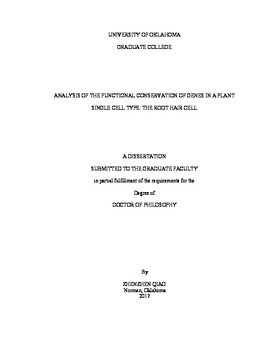| dc.description.abstract | The evolution of plant species is tightly associated with major changes in their genome such as their allopolyploidy and autopolyploidy. These paleopolyploid events and recent genome duplications have contributed to the large sizes of the plant genomes and to the abundance of duplicated genes. This increases genomic content and, as a consequence, provides material for genetic mutations, drift, and selection. Therefore, genome duplication creates new possibilities of molecular evolution. Several studies focusing on the evolution of duplicated genes during plant development and in response to environmental stresses has been conducted. However, the cellular complexity of the plant organs used in these studies represents a difficulty to precisely characterize the molecular and functional conservation and divergence of duplicated genes.
In this dissertation, taking advantage of publicly available genomic and transcriptomic sequences and functional genomic datasets, we aimed to precisely delineate the conservation and divergence of plant gene transcription and protein function. This analysis has been conducted with an unprecedented level of resolution using a single plant cell type, the root hair cell which emerged around 400 million years ago (mya). The rationale of the selection of this single plant cell type to conduct the projects is the following: the molecular response of a plant tissue or organ, which is often selected when conducting plant molecular studies, is a reflection of the average molecular reponses of the different cell types composing the tissue/organ. This cellular complexity is a limitation in our understanding of the molecular evolution of plant genes. This concept will be largely discussed in the introduction of this dissertation (Chapter 1).
In chapter two, we described the development of an innovative plant culture system, the ultrasound aeroponic system, to access the root hair cells. This innovative plant culture system not only provides easy access to isolated root hair cells but also facilitates root hair observation and isolation, as well as the generation of transgenic root hair cells to enhance functional genomic studies. Finally, the ultrasound aeroponic system is compatible with the application of biotic and abiotic treatments on the plant root system. This is important because it opens avenues to precisely understand the adaptation of different plant species to environmental stresses and the evolution of these responses.
In chapter 3, mining the Arabidopsis (Arabidopsis thaliana) and soybean (Glycine max) genome sequence and root hair transcriptomes, we performed a comparative analysis to reveal the molecular evolution of plant genes at the single cell type level. Our analysis revealed that the transcriptional activity of plant genes and the mechanisms controlling their expression in root hair cells are highly conserved between plant species.
Focusing on nodulation, a biological process initiated by the symbiotic interaction between nitrogen-fixing bacteria (Rhizobia) and the legume root hair cell, we also performed a comparative genomic and transcriptomic analysis of the major regulators of the nodulation process and their homologs. This analysis is reported in Chapter 4. This study revealed the level of conservation and divergence of the nodulation-related genes across various legume species.
In chapter 5, we further examined the molecular and functional conservation of genes and proteins by performing a comparative functional analysis of two regulators of the nodulation process: GmFWL1 and its interaction partner, a flotillin protein. Both proteins are microdomain-associated proteins. In response to rhizobial infection, these proteins translocate to the root hair cell tip where rhizobial recognition and invasion occur prior to the initiation of the infection process. Similar localization patterns of the Medicago (Medicago truncatula) flotillin ortholog in response to rhizobial infection (i.e., translocation at the tip of the root hair cell) suggests the conservation of the soybean and Medicago flotillin cellular functions and, more broadly, the role of plasma membrane microdomains during the nodulation process.
This dissertation describes the use of a plant single cell type, the root hair cell, to study the conservation of plant genes expression and function. This work will expand our knowledge in plant evolutionary biology. | en_US |
